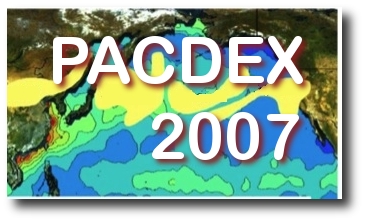| |
PACDEX Planning Meeting - 12
October 2006
|
|
We were very pleased with the PACDEX planning meeting
that was
held on October
12 at the RAF. 32 people attended the meeting, representing all the NSF
PACDEX
PIs and several other groups. Some noteworthy items from the meeting
include:
- The group from NASA Langley (led by Pat Minnis) was
represented by Kirk Ayers,
who expressed an interest in collaborating scientifically with the
project
(under NASA support). They offered to provide customized satellite
products for
forecasting, nowcasting, and post project analysis. The software that
they use
for display of the data and the customized data products they plan to
provide
for the PACDEX archive will be especially helpful. We may need NSF to
send a
letter to NASA inviting/requesting their participation. Julie Haggerty,
a
scientist in EOL, does water/ice discrimination with satellite data and
she has
worked with Pat and Kirk before. Julie will join the PACDEX group of
scientists
and she plans to collaborate with the Langley group to document water
and ice
clouds during PACDEX.
- The group from NRL Monterey (Doug Westphal and
Anthony
Bucholtz, who could not
attend but sent slides) will provide forecasting support for the
project
(Westphal), using the NOGAPS, NAAPS, and COAMPS models. Anthony
Bucholtz has
offered to provide data from their MAARCO Mobile Atmospheric Aerosol
and
Radiation Characterization Observatory for PACDEX.
- Ken Sassen (U. of Alaska, Fairbanks, who could not
attend
but sent slides)
will provide lidar data from a cloud polarization lidar, a polarization
diversity lidar, and a W-band Doppler radar, for the cases where the
plume goes
over Fairbanks. An overflight of his site should be quite possible,
since some
of the PACDEX operations should be conducted out of Anchorage.
- Greg Carmichael was not able to attend, but he sent
slides
to describe the
products he was planning to make available for project forecasting. He
also
described how his model could be customized for specific variables of
interest.
- Phil Rasch represented the NCAR CGD modeling group.
They
expect to help lead
the decision making for the PACDEX flights. We discussed flight
planning
scenarios with Phil in both a forecasting and real time (flight
support) mode.
We hope to start pre project forecasting (dry runs) about two weeks
prior to the
start of the project.
- José Meitín (EOL Field Project
Services) will
provide overall project
coordination and Greg Stossmeister (EOL, CDS) will provide data
management and a
data catalog for the project. They outlined and discussed the services
that will
be provided to the project.
- The PACDEX instrumentation PIs (Twohy, Baumgardner,
Anderson, DeMott, Roberts)
attended along with the HAIS instrument PIs (Campos, Pilewskie,
Heymsfield).
Each instrument was discussed in the context of what flight and
installation
requirements were planned. Peter Pilewskie also hopes to participate in
the
analysis of data from PACDEX in addition to his role as a data provider
for HARP
(HIAPER radiation instrument). He will likely contact you about a
proposal for
his scientific interests.
- Pavel Romashkin (RAF PACDEX project management lead),
Dave
Rogers (RAF), and
Kurt Zrubek discussed the aircraft payload, inlet and configuration
issues.
Zrubek led a discussion of certification procedures. We don't see any
major
problems right now, but the certification and flight testing schedule
will be
tight. We discussed the possibility of moving the project ahead a
couple of
weeks, but agreed that we need to wait a few more weeks before a final
decision
is made.
- Although we do not plan to fly west of Japan, two
groups in
China (Peking
University and Lanzhou University) have agreed to provide ground and
lidar data
to the project. Yan Feng (Scripps) will coordinate the effort with the
Chinese
and use their data for her studies on the origin of dust. A group from
Korea
(Seoul National University) has also agreed to provide Lidar and
ground-based
data. The data from each of these groups will be helpful for launch
decisions
and for providing source characterization data for dust events.
- Al Cooper (G-V Chief Scientist) also attended the meeting. He plans to
participate in PACDEX. He was
a great help to T-Rex and we expect him to play an important role in
this
project, especially in coordinating the effort to implement the new
HIAPER
instruments and other data sources for the project. Al's background in
cloud
physics should be most helpful to the project. Also, this "rapid
deployment,
long flight leg" research is somewhat of a new paradigm for NCAR (and
our PIs)
that we hope will become more routine. Al is working to make this a
reality for
HIAPER.
- Several NCAR management groups were represented at
the
meeting, including
Karyn Sawyer (EOL Director's office), Brigitte Baeuerle (EOL, FPS),
Mike Daniels
(EOL, CDS) and Frank Flocke (ACD, CARI group lead).
In summary we were pleased at the participation in this project and the
prospects for a good study. We hope to do two more planning meetings,
with one
possibly being done at the AGU meeting later this year.
Jeff and Ram
|
 Return
to the PACDEX page Return
to the PACDEX page
|
Last update Thu, 30 November 2006
E-mail
comments

|
|


